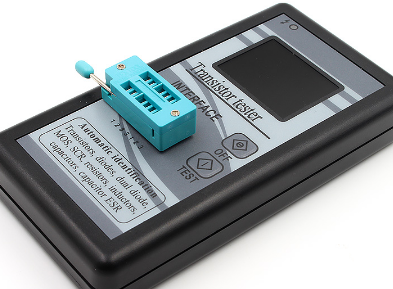
With the help of such a device it is possible to identify problematic and "dead" radioelectronic Components. Note that in addition to transistors, it is also possible to test other elements, be they semiconductor (diodes, thyristors, etc.) or passive (capacitors, resistors, etc.).
In addition to the device itself, the delivery package includes a 14-pin ZIF connector for connecting and fixing elements with a lever clamp. The device is placed in a nice case made of high-quality plastic, due to which it has a finished and aesthetic appearance. A blue LED is displayed on the front panel, indicating that the device is working. We also note the presence of the “Test” and “Off” buttons. Using the latter, you can immediately turn off the device, thereby saving battery power.
During power-up, a software version message appears on the device’s screen. It should be noted here that “out of the box” the device does not work in the fastest way, and there is also a slight, but still an error in the measurement results. If you want to "cure" it is possible by installing firmware from the Internet
After connecting the element to the tester, you need to click on the “Test” button and after ~ 30 seconds a graphic designation of the component with its pinout and characteristics will appear on the screen. If the part is defective, then the display will read “No, unkown or damage part”.
Specifications fixtures the following:
• Display: TFT (color) with a resolution of 128 x 160;
• Shutdown current: 20nA;
• Measuring resistance range: 0.5 Ohm - 50M Ohm;
• Inductance measurement range: 0.01 mH - 20 H;
• Capacitance measuring range: 25 pF - 100000 uF;
• Operating temperature: 0 ° C to + 40 ° C
• Battery: 9V type "Crohn" (not included!);
• Case size: 135 x 70 x 24 mm (Length x Width x Height);
• Weight: 99 g.
Cost: ~ 920
